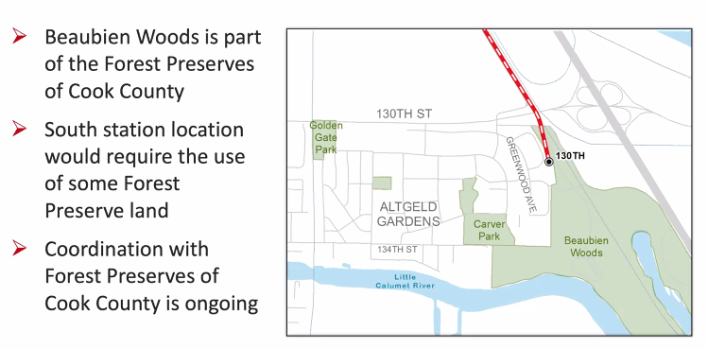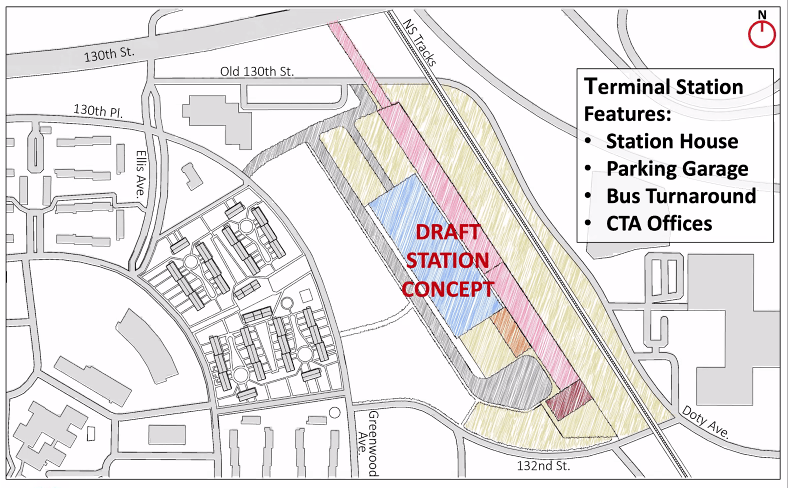Far South Siders who attended the January 27 virtual community meeting on the future 130th Street Red Line ‘L’ station said that they want a grocery store in the area, as well as a initiatives to clean up decades of decades of soil contamination and reduce pollution coming from the nearby industrial areas and landfills.
As part of the planning process for the long-awaited Red Line extension to 130th Street, the CTA and the city are creating the Transit-Supportive Development Plan that, as the name suggests, will guide development around the future stations. 130th Street station, the line’s future southbound terminal, would be located in Altgeld Gardens, a housing project that currently doesn’t have many transit links to the rest of the city, or much in the way of places to buy groceries, and other amenities. Furthermore, the area has experienced decades of pollution, to say nothing of a nearby landfill one attendee mockingly called “Mount Garbage.”
This meeting was the first in the series of station-specific hearings. The CTA plans to hold workshops for the future Michigan Avenue, 111th Street and 103rd Street stations throughout February.
The long-awaited extension
While the Red Line's northern terminus is Howard Street, on Chicago’s northern border, its southern terminal is at 95th Street, well short of the southern city limits at 138th Street. Far South Side riders have to rely on less frequent (and, until recently, more expensive) Metra trains, and CTA and Pace buses that are relatively slow because they're at the mercy of traffic generated by private vehicle drivers.
The challenges are particularly acute in the largely industrial Riverdale community area (not to be confused with the suburb of Riverdale southwest of it.) The Altgeld Gardens and Murray Homes public housing developments account for the majority of the community’s residential areas. The CTA's #34 South Michigan bus provides the only transit link between those developments and the rest of the city. Pace Route 353 runs express through most of Riverdale, only serving the Eden Green affordable housing development at the community’s west end. The closest Metra station is the Riverdale Metra Electric Line stop, which is located in the eponymous suburb.
As noted during at this week's meeting, while the CTA previously planned to build the south terminal on the north side of 130th Street (with the rail yards built closer to 115th Street), the Chicago Housing Authority’s demolition of Altgeld Garden’s three easternmost blocks in 2017 freed up land on the other side of the street.

During the meeting, CTA senior planning manager Solani Tandon promised that the station design would complement the surrounding community. The preliminary plan calls for it to have three tracks and two platforms, with the station house at the south ends of the platforms, near 132nd Street. The bus turnaround would be located directly west of the entrance. Tandon said that it would be served by “several bus routes,” but didn’t elaborate on what those routes might be, and whether any of the routes will be new.
The station will also have a parking garage north of the turnaround, “so that people who live further east and west, and in the south suburbs, can reach the station by car.” It is worth noting that there are currently no public transportation connections between Riverdale and any neighborhoods or towns to the east.
Tandon said that building the station south of 130th Street would require the route to pass through a portion of Beaubien Woods forest preserve. CTA is currently negotiating with the Forest Preserve District of Cook County to figure out the details.

Marlise Fratinardo, the CTA’s Senior Project Manager, said that the station would shorten the commute from 130th to the Loop by 20 minutes, “put residents within the reach of jobs,” and address decades of disinvestment an area with a high number of transit-dependent residents. She also noted that all new stations would have location bus connections, which would improve transfers.
Transit-Supportive Development Plan
As part of the extension planning process, the CTA, the Chicago Department of Planning and Development and the Cook County Land Bank Authority are working to develop a Transit-Supportive Development Plan to guide development in the zones within two miles of each new station. The land bank owns multiple properties along the extension (mostly between 111th and 115th Street) and so does the city. DPD processes zoning change applications, as well as changes to Tax Increment Financing districts, before they go before the City Council for a vote. All of this means that the plan might actually have some legal weight.
Teresa Fourcher, a consultant for the project, said that the plan will be guided by the principle of equitable transit-orientated development. “The plan will identify opportunities for economic development and ensure continued affordability for residents who live there,” she said. “We will collaborate with the city of Chicago agencies, including DPD, Housing, [the Chicago Department of Transportation] and many others.” Fourcher added that they will also take past community plans into account, because they “want to make sure that good work that was being done in past is being carefully considered.”
The CTA polled the attendees on what they wanted to see near 130th. A new farmer’s market emerged as an overwhelming favorite (not a surprise, considering that most of Far South Side is a food desert), followed by biking and walking trails and “plazas and other gathering spaces.” In terms of what new jobs they would like to see in the community, healthcare providers got the most votes, followed closely by restaurants, transportation, and warehousing.
In terms of residential development, attendees voted overwhelmingly in favor of single-family homes, and there wasn’t much interest in taller housing and and mixed-use housing with retail spaces on the first floor. Unlike most Chicago public housing developments, Altgeld Gardens never had a high-rise component.
During the breakout session I attended, Cheryl Johnson, of Altgeld Gardens, praised the tight-knit community she lived in, where neighbors check on each other without a second thought, which she described as the development’s greatest asset. She said that, given how much the community has been neglected over the decades, and how much pollution they had to deal with, there was nowhere to go but up.
“I would like to be able to dock my boat right off Beaubien Woods,” she said. “The most important thing is transportation, and I want it to be safe. I don't want any new entity to come into the area that continues to pollute the area, to degrade the area, because we bore the burden for so many years, and it's time to shift the paradigm.”
Annette Reed was one of the several attendees who said that the community badly needs a grocery store. Another resident suggested more landscaping elements, to help make the area greener and more attractive.
Deborah Truss, a board member with the Red Line Extension Coalition and a resident of neighboring Roseland since 1972, said she would also like to see educational opportunities for local high schoolers looking to get into construction and other trades. “That's something I'm planning to do in future, to recruit, and planning to expose people in the community to various trades and carrier opportunities” she said.





